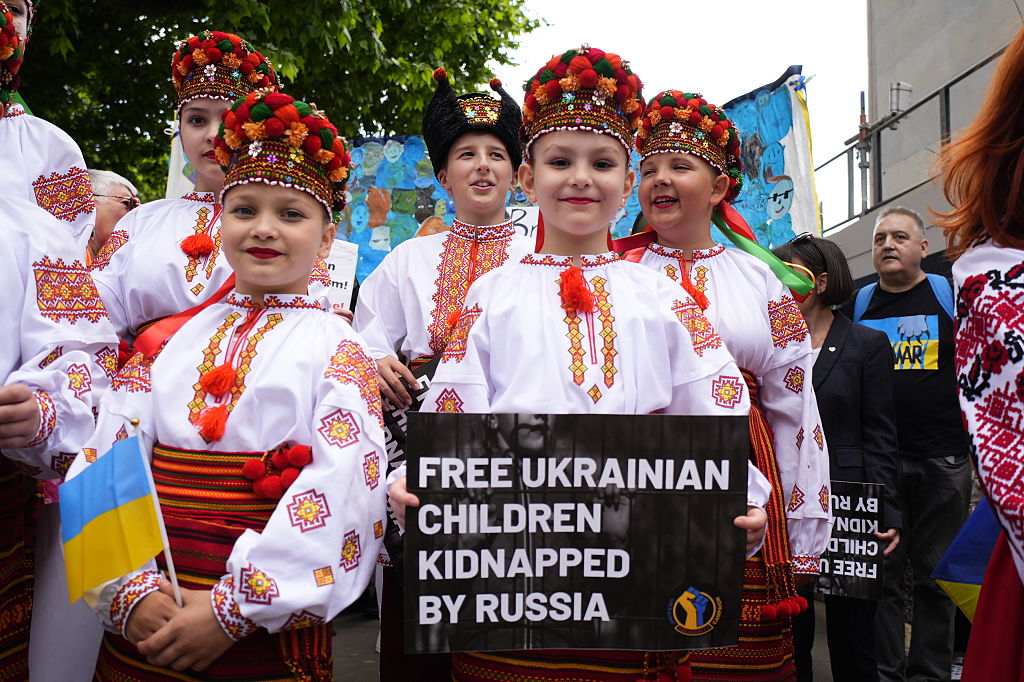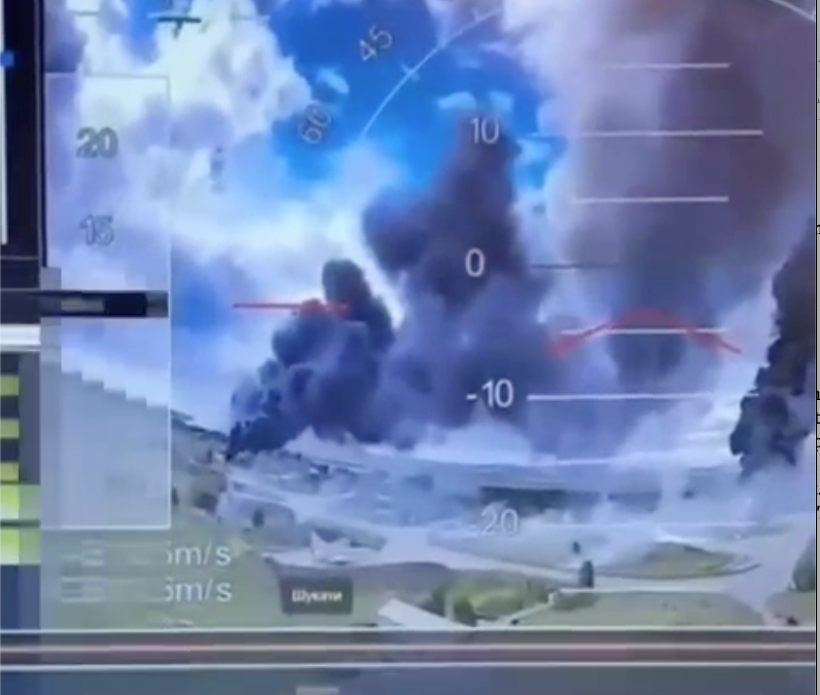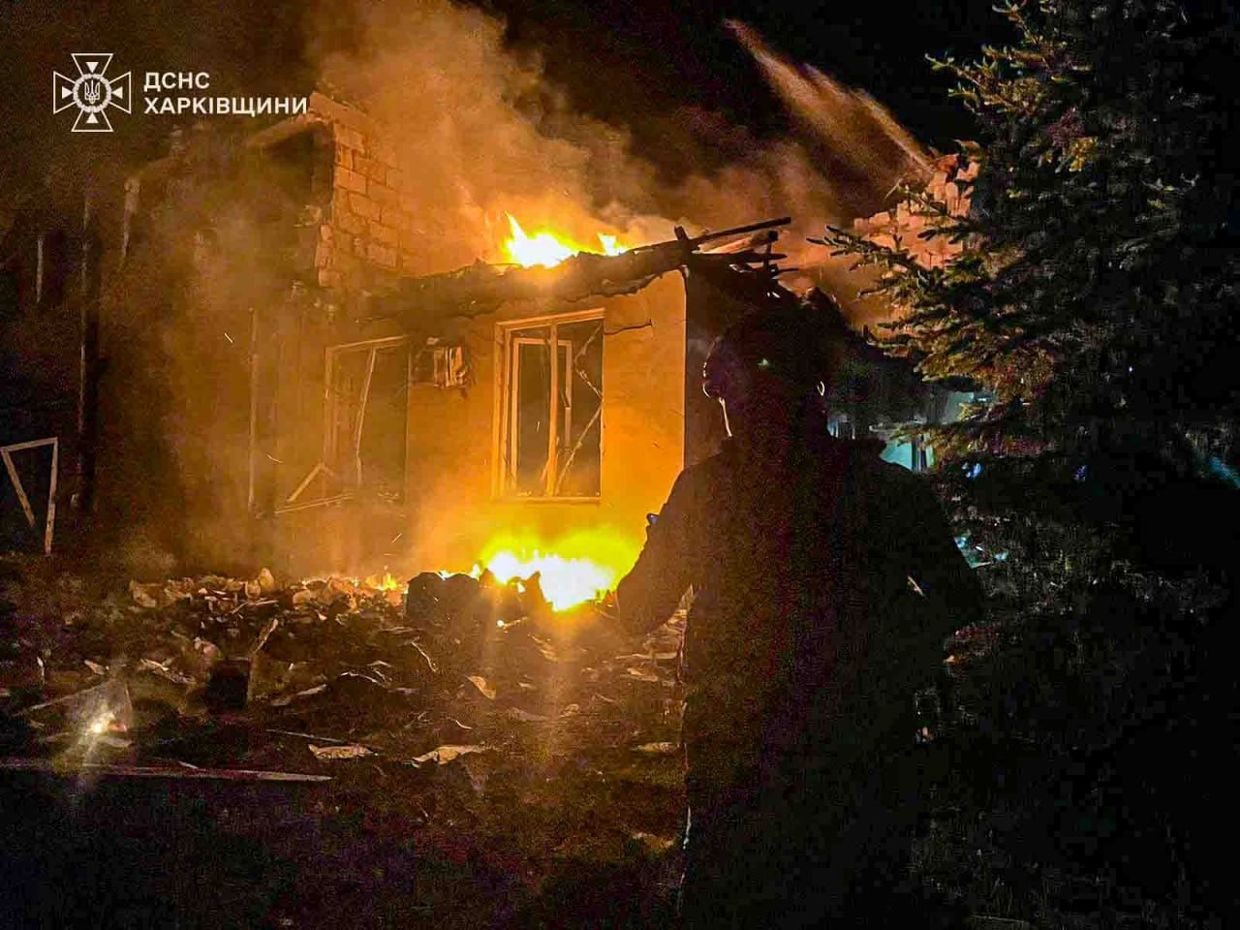As Ukrainian drones destroy $7 billion in Russian bombers across four airfields, Moscow responds with record-breaking aerial assault while peace talks loom
Summary of the Day – June 1, 2025
In the most ambitious covert operation of the war, Ukraine’s Security Service executed a meticulously planned 18-month mission that brought fire and devastation to Russian airfields as far as Siberia. Codenamed “Operation Spiderweb,” the strike destroyed 41 strategic bombers worth an estimated $7 billion across four military installations, crippling 34% of Russia’s cruise missile carriers in a single coordinated blow. Yet even as Ukrainian drones found their targets thousands of kilometers from home, Russia launched its largest aerial assault of the conflict—472 drones and seven missiles—underscoring the brutal arithmetic of a war where each tactical victory comes shadowed by escalating retaliation. The day’s events cast a stark backdrop for the second round of peace talks scheduled for June 2 in Istanbul, where Ukrainian negotiators will sit across from Russian delegates while both sides’ aircraft burn and civilians die.

People taking part in the Ukraine Solidarity Campaign march, demanding Russia return abducted Ukrainian children, in central London, United Kingdom. (Jordan Pettitt/PA Images via Getty Images)
The Deepest Strike: Ukrainian Drones Reach Russia’s Siberian Heartland
At precisely coordinated moments across the Russian Federation, wooden cabins mounted on seemingly innocent trucks suddenly split open like mechanized flowers, releasing swarms of first-person-view drones into the pre-dawn darkness. The unprecedented operation struck Belaya Air Base in Irkutsk Oblast—more than 4,000 kilometers from Ukraine—alongside Olenya Air Base in Murmansk Oblast, Dyagilevo Air Base in Ryazan Oblast, and Ivanovo Air Base in Ivanovo Oblast.
“The SBU first transported FPV drones to Russia, and later, on the territory of the Russian Federation, the drones were hidden under the roofs of mobile wooden cabins, already placed on trucks,” an SBU source revealed. “At the right moment, the roofs of the cabins were opened remotely, and the drones flew to hit Russian bombers.”
The operation targeted the aircraft Russia deploys daily to terrorize Ukrainian cities: A-50 early warning planes worth $350 million each, Tu-95 strategic bombers capable of carrying 16 cruise missiles, and Tu-22M3 supersonic bombers that launch the dreaded Kh-22 missiles Ukraine struggles to intercept. President Volodymyr Zelensky confirmed that Ukrainian authorities had safely extracted all operatives involved in the mission before its execution, calling it “an absolutely brilliant result” achieved “solely by Ukraine.”

A screenshot from a video of the alleged attack released by the SBU. (Ukraine’s Security Service)
The strike reached depths of Russian territory previously thought impossible for Ukrainian conventional forces, demonstrating a level of operational sophistication that has fundamentally altered the strategic calculus of the conflict.
The Phantom Trucks: How Ukraine Smuggled War Into Russia’s Backyard
The genius of Operation Spiderweb lay not in its technology but in its audacity. For 18 months, Ukrainian intelligence operatives worked to position FPV drones—commercial aircraft costing mere hundreds of dollars—within striking distance of bombers worth hundreds of millions. The operation required infiltrating Russian territory, establishing supply lines, coordinating precise timing across multiple time zones, and maintaining operational security over an unprecedented geographic scope.
Videos released by the SBU showed the moment of execution: truck roofs mechanically retracting to reveal neat rows of drones, which then launched in coordinated waves toward their targets. The footage captured Russian bombers erupting in flames across the tarmac, each explosion representing months of planning and millions of dollars in destroyed Russian capability.
SBU Chief Vasyl Malyuk personally oversaw the operation alongside President Zelensky, who had monitored its development throughout its 18-month gestation. The successful extraction of all personnel before the strikes began demonstrated the operational maturity Ukrainian intelligence has achieved after three years of war.
Russian officials scrambled to respond, with Irkutsk Oblast Governor Igor Kobzev confirming “a drone attack on a military unit” and noting that the “source” was a truck, while Murmansk Governor Andrey Chibis acknowledged that “enemy drones have attacked the territory of the Murmansk region.”

Smoke rising in Russia’s Irkutsk Oblast following a Ukrainian drone attack on a Russian airbase. (Reuters)
Record-Breaking Retaliation: Russia’s 472-Drone Assault
Even as Ukrainian drones struck deep into Russian territory, Moscow was preparing its own devastating response. The night of May 31 to June 1 witnessed Russia’s largest drone attack of the war: 472 Shahed-type attack drones accompanied by three Iskander-M ballistic missiles and four cruise missiles.
Ukrainian air defenses shot down 210 drones while electronic warfare systems suppressed another 172, but the sheer volume overwhelmed defensive capabilities across multiple regions. Russian forces struck Dnipropetrovsk, Kharkiv, Kyiv, and Odesa oblasts, damaging both civilian and military infrastructure in what appeared to be Moscow’s answer to mounting Ukrainian long-range capabilities.

Firefighters extinguish a blaze in Kharkiv Oblast following a mass Russian drone strike overnight. (Ukraine’s State Emergency Service / Telegram)
The attack’s timing—occurring simultaneously with Ukrainian preparations for Operation Spiderweb—revealed the cruel mathematics of modern warfare: as Ukraine’s capacity to strike Russian strategic assets has grown, so too has Russia’s willingness to target Ukrainian civilians in ever-larger numbers.
The escalation underscored Russia’s adaptation to Ukrainian innovations. Where Ukrainian forces once struggled to reach targets beyond the immediate border regions, operations like Spiderweb now force Russian commanders to consider air defense requirements across the entirety of their vast territory.
The Cost of Command: Ukrainian General Resigns After Training Ground Strike
Tragedy struck closer to home when a Russian missile attack on a Ukrainian training facility in Dnipropetrovsk Oblast killed 12 soldiers and wounded over 60. The strike prompted an unprecedented response from Major General Mykhailo Drapatyi, Ukraine’s Ground Forces Commander, who submitted his resignation in a rare acknowledgment of command responsibility.
“Twelve dead. There are injured. These are young lads from the training battalion. Most of them were in shelters. They should have learned, lived, and fought—not died,” Drapatyi wrote in his resignation statement.
The general’s decision reflected deeper tensions within Ukraine’s military leadership over training safety and command accountability. Drapatyi specifically cited his inability to ensure proper execution of orders and criticized a command culture unwilling to accept personal responsibility for battlefield failures.
The Russian strike targeted the 239th Polygon north of Dnipro, a facility previously hit in March during a similar attack that prompted Drapatyi’s earlier warnings about accountability. His resignation—a rarity among senior Ukrainian commanders—highlighted the personal toll of leadership in a war where every decision carries life-and-death consequences.
Diplomatic Theater: Peace Talks Amid Burning Aircraft
As aircraft burned across Russia and Ukraine, diplomatic preparations continued for the second round of direct peace talks scheduled for June 2 in Istanbul. President Zelensky announced an updated 14-member Ukrainian delegation led by Defense Minister Rustem Umerov, expanding the original negotiating team to include new figures from military, human rights, and legal sectors.
The timing could hardly be more complex. Ukraine’s devastating strike on Russian strategic bombers demonstrated Kyiv’s growing capacity to threaten Russian military assets far from the front lines, while Russia’s record-breaking drone assault showed Moscow’s continued willingness to target Ukrainian civilians and infrastructure.
Russian Foreign Minister Sergey Lavrov and U.S. Secretary of State Marco Rubio held a phone call to discuss the upcoming talks, with both sides expressing cautious optimism despite the escalating attacks. Ukraine has prepared a detailed roadmap calling for a minimum 30-day ceasefire, full prisoner exchanges, and the return of Ukrainian children taken to Russian-held areas.
Yet Russia has consistently rejected unconditional ceasefire proposals, instead demanding Ukrainian recognition of illegally annexed territories, troop withdrawals from Ukrainian-controlled portions of these regions, and adoption of neutral status—conditions Ukrainian officials describe as tantamount to surrender.
The Nuclear Card: Russia’s Familiar Threats Amid Military Humiliation
As news of the devastating strikes on Russian airbases spread, Moscow’s propaganda machine immediately escalated to nuclear rhetoric. Russian political scientist Sergei Markov, amplified by state media outlet Moskovsky Komsomolets, claimed the Ukrainian strikes constituted grounds for nuclear weapons use under Russia’s doctrine because they targeted strategic nuclear potential.
Kremlin-affiliated milbloggers echoed these threats, explicitly calling for nuclear retaliation against Ukraine. The response followed a familiar pattern: whenever Ukrainian forces achieve significant tactical success against Russian military targets, Moscow responds with nuclear saber-rattling designed to deter Western support and limit Ukrainian operational capabilities.
Russian officials and milbloggers also criticized their own military leadership for failing to protect strategic assets. Retired Lieutenant General Andrei Gurulev blamed Russian special services for allowing trucks to approach the airbases, while milbloggers condemned the military command’s decision to store strategic aircraft in open-air facilities with insufficient defenses.
The criticism reflected deeper frustrations within Russian military and political circles over Ukraine’s growing capacity to strike targets previously considered safe due to their distance from the front lines.
False Flags and Train Derailments: Russia’s Escalating Blame Game
In western Russia, two railway bridges collapsed on May 31, causing train derailments that killed seven people and injured 69 others. Russian officials immediately blamed Ukraine without providing evidence, with State Duma Deputy Andrei Kolesnik claiming Russia should respond “harshly” to the incidents.
Federation Council Committee Chairperson Andrei Klishas used the derailments to call for a “vast” buffer zone in Ukraine and reiterated Russia’s original war aims of “denazifying” and “demilitarizing” Ukraine. The rhetoric suggested Russian officials are using the incidents to justify expanded territorial ambitions and continued military operations.
Ukrainian Center for Countering Disinformation Head Lieutenant Andriy Kovalenko suggested Russia might be conducting false flag operations to disrupt peace processes and prolong the war. The timing of the incidents—just as peace talks were being finalized—raised questions about whether Russian hardliners are sabotaging diplomatic efforts.
The Arithmetic of Attrition: Russia’s Irreplaceable Losses
The strategic impact of Operation Spiderweb extends far beyond immediate battlefield effects. Russia faces severe challenges in replacing the destroyed aircraft, particularly A-50 early warning planes that cost approximately $500 million each and of which Russia has fewer than ten operational.
Ukrainian military observer Yuriy Butusov noted that Ukrainian forces destroyed aircraft that Russia no longer produces, while Kremlin-affiliated milbloggers acknowledged that Russia cannot manufacture replacement chassis for Tu-95 and Tu-22 bombers. The Economist reported that Russia likely has fewer than 90 operational strategic bombers in total.
This industrial limitation has already forced Russia to increasingly rely on Sukhoi aircraft rather than strategic bombers for cruise missile launches, suggesting Moscow is attempting to preserve its limited strategic aviation assets. The destruction of 41 bombers in a single operation represents a significant portion of Russia’s operational fleet.
The economic impact—an estimated $7 billion in destroyed aircraft—dwarfs the cost of the drones used to achieve it, demonstrating the cost-effectiveness of Ukraine’s evolving drone warfare capabilities.
Border Pressures: Russian Advances Across Multiple Fronts
While Ukrainian drones struck deep into Russia, Russian forces continued grinding advances along multiple sectors of the front. Geolocated footage confirmed Russian advances southeast of Kostyantynivka in Sumy Oblast, with Russian sources claiming forces had nearly reached artillery range of Sumy City.
Ukrainian authorities report Russia has deployed 125,000 personnel along the borders of Sumy and Kharkiv oblasts, where Russian forces are conducting offensive operations framed as efforts to create buffer zones. The advance reflects Russia’s expanded territorial ambitions beyond the originally claimed territories of Luhansk, Donetsk, Zaporizhia, and Kherson oblasts.
Russian forces also made confirmed advances in the Toretsk direction, seizing the settlements of Dyliivka and Zorya through coordinated attacks involving elements of the 4th Motorized Rifle Brigade and 13th “Rusich” Detachment. Ukrainian forces reported Russia conducted attacks with six motorcycles near Leonidivka, reflecting continued adaptation of tactics to counter Ukrainian drone surveillance.
Across other sectors, Russian forces maintained pressure in the Kupyansk, Lyman, Pokrovsk, and Kurakhove directions without confirmed territorial gains. Ukraine’s General Staff reported 166 combat clashes across the front on June 1, illustrating the sustained intensity of ground combat even as both sides deployed unprecedented long-range strike capabilities.
Electoral Upset: Poland’s Nationalist Victory Clouds Ukrainian Relations
In a development with significant implications for Ukrainian support, Karol Nawrocki won Poland’s presidential election with 50.89% of the vote, defeating the pro-EU Rafal Trzaskowski. Nawrocki, supported by the opposition Law and Justice party, has been criticized for adopting pro-Russian narratives and opposing Ukraine’s NATO membership.

Karol Nawrocki, winner of the Polish presidential election, on the evening of the second round of the vote in Warsaw, Poland. (Jakub Porzycki/Anadolu via Getty Images)
The narrow victory represents a potential shift in Polish-Ukrainian relations, as Nawrocki has signed declarations pledging to block Ukraine’s NATO accession. While both candidates supported increasing defense spending and backing Ukraine against Russian invasion, they diverged sharply on Ukraine’s alliance prospects.
Russian disinformation campaigns targeted the election, particularly amplifying anti-Ukrainian sentiment in Poland. The victory of a candidate opposed to Ukrainian NATO membership could complicate Western alliance cohesion at a critical moment in the conflict.
Surrender in the Ranks: Russian Soldiers Choose Captivity Over Abuse
Ukrainian Airborne Assault Forces reported that a group of Russian soldiers surrendered in the Kursk direction, citing abuse by their own commanders as worse than captivity. The soldiers described being subjected to “inhumane treatment, psychological pressure and threats” within their units.

A screenshot from the video released by Ukraine’s Airborne Assault Forces. (Ukraine’s Airborne Assault Forces)
The surrenders reflected documented patterns of systematic abuse within Russian military units, where “punishment squads” target soldiers for perceived infractions through beatings and confinement. One soldier described being “blown up immediately” after being sent to the front, leaving only two survivors in his unit.
Ukrainian forces have captured 971 Russian military personnel during operations in the Kursk region since Ukraine’s August 2024 incursion, with the June 1 surrenders adding to the growing number of Russian troops choosing captivity over continued service. The incidents underscore the human cost of Russia’s military mobilization efforts and the deteriorating conditions within Russian forces as the war extends into its fourth year.
Underground Warfare: Partisan Strikes Deep Behind Enemy Lines
As the main battle rages, Ukraine’s shadow war continued with devastating effect. The Ukrainian partisan group Atesh claimed responsibility for sabotaging a railway in occupied Donetsk Oblast, while Ukraine’s military intelligence reported the destruction of a Russian military train carrying fuel and food near Melitopol in occupied Zaporizhzhia Oblast.
“The Muscovites’ key logistical artery on the occupied territory of Zaporizhzhia Oblast and Crimea has been destroyed,” military intelligence reported, noting heightened Russian searches and stricter checkpoints as occupation forces scrambled to find those responsible.
The sabotage operations represent the expanding network of resistance within Russian-occupied territories, where Ukrainian partisans and intelligence operatives maintain the capacity to strike critical infrastructure far from conventional front lines.
Britain’s Nuclear Gambit: F-35s and the Return of Tactical Deterrence
In London, defense planners announced ambitious plans to acquire U.S.-made F-35A Lightning stealth fighters capable of launching tactical nuclear weapons, marking Britain’s most significant nuclear capability expansion since the Cold War. The Sunday Times reported that the new air fleet forms a key component of the UK’s strategic defense review, set for public release on June 2.
The British military, which can currently only launch nuclear weapons from submarines after decommissioning air-based platforms at the Cold War’s end, seeks to restore tactical nuclear delivery capabilities specifically in response to Russian threats. The comprehensive review calls for £6 billion in additional ammunition production through six new factories, expansion of the navy’s destroyer and frigate fleet from 14 to 25 vessels, and consideration of a new missile defense shield.
The broader plan envisions boosting British defense spending to 3% of GDP by 2034, reflecting European recognition that the Russian threat requires fundamental military restructuring. The timeline mirrors similar rearmament efforts across NATO as member states grapple with the reality of sustained confrontation with Moscow.
Dawn in Kharkiv: The Morning After the Storm
As dawn broke on June 2, Kharkiv faced yet another brutal awakening. Russian forces struck the city with drones and ballistic missiles, injuring at least six people including a 7-year-old boy. Two ballistic missiles targeted the Kyivskyi district, with one striking just meters from a local school and another near high-rise buildings.
“It is a miracle that there were no casualties,” Mayor Ihor Terekhov reported, surveying shattered windows and damaged facades across the city. The attack followed President Zelensky’s evening warning that Russia was preparing another massive strike in response to Operation Spiderweb.
The morning assault underscored the grim cycle that has defined this war: Ukrainian tactical victories met with Russian retaliation against civilian targets, each success shadowed by the knowledge that more civilian suffering will follow.
Educational Resilience: Building Ukraine’s Future Amid War
In a quieter corner of Ukraine’s war effort, experts from Britain’s Coventry University participated in President Zelensky’s forum on education reform and reconstruction resilience. Sir Ciaran Devane, Director of the university’s Research Centre for Peace and Security, addressed the contribution of higher education to Ukraine’s post-war rebuilding.
The forum highlighted ongoing partnerships between Ukrainian and British institutions, including projects to develop Gender Equality Partnerships and increase women’s representation in academic leadership. Coventry University has established collaborations with Alfred Nobel University and Kyiv National University of Construction and Architecture through the Twinning Ukraine project, exploring joint degree programs and research initiatives.
Additional partnerships include training for healthcare workers and rehabilitation specialists caring for war-wounded patients, demonstrating how educational cooperation extends beyond traditional academic boundaries. Such initiatives represent the parallel war being fought for Ukraine’s institutional future—the recognition that military victory alone cannot guarantee the democratic, educated society Ukrainians are fighting to preserve.
The Toll of War: Russia’s Mounting Losses and Equipment Destruction
Ukraine’s General Staff reported that Russian military losses had reached 988,560 personnel since the February 2022 invasion began, with 1,230 additional casualties recorded on June 1 alone. The figures, representing troops killed or wounded severely enough to be removed from combat, illustrate the grinding attrition that has characterized this conflict.
Equipment losses continued mounting as well: 22,656 armored fighting vehicles destroyed or damaged (including four on June 1), 50,325 vehicles and fuel tanks lost (127 on June 1), 28,527 artillery systems eliminated (52 on June 1), and critically, 372 aircraft destroyed throughout the war. The dramatic single-day loss of 41 aircraft in Operation Spiderweb represents one of the largest equipment losses Russia has suffered in any 24-hour period.
Ukrainian forces also reported destroying 38,366 Russian drones (151 on June 1), 10,872 tanks (five on June 1), and 1,401 multiple launch rocket systems. The daily destruction rate reflects the sustained intensity of combat across multiple fronts, with Russian forces continuing to suffer significant materiel losses even as they maintain offensive pressure.
Diplomatic Choreography: Lavrov and Rubio’s Pre-Negotiation Dance
Hours before the scheduled Istanbul talks, Russian Foreign Minister Sergey Lavrov and U.S. Secretary of State Marco Rubio held a phone call to discuss the upcoming negotiations. The State Department confirmed Russia had requested the call, with Rubio reiterating President Trump’s call for direct talks to achieve “lasting peace.”
The diplomatic contact reflected the complex choreography surrounding the peace process, where public statements, private communications, and battlefield developments all contribute to negotiating positions. Lavrov’s conversation with Rubio occurred as Russian aircraft burned across four airfields, illustrating the disconnect between diplomatic protocol and military reality.
Looking Forward: The Fragile Arithmetic of Peace
As Ukrainian and Russian delegations prepare for their second round of direct talks in Istanbul, the events of June 1 illustrate the profound challenges facing any peace settlement. Ukraine has demonstrated unprecedented capability to strike Russian strategic assets across vast distances, while Russia has shown its willingness to respond with record-breaking civilian attacks.
The success of Operation Spiderweb may actually complicate peace negotiations by demonstrating Ukraine’s growing capacity to threaten Russian military infrastructure far from the front lines. Russian nuclear rhetoric in response to the strikes suggests Moscow may be less willing to make concessions when facing such operational pressure.
Yet the human toll continues mounting on both sides. From Ukrainian soldiers killed in training to Russian troops surrendering rather than enduring abuse, the war’s cost in lives grows daily while diplomatic solutions remain elusive. Meanwhile, Britain’s nuclear rearmament and Poland’s electoral shift toward nationalism signal broader European recognition that this conflict has fundamentally altered the continent’s security landscape.
The Istanbul talks will unfold against this backdrop of escalating military capabilities and deepening human suffering. Whether June 2 brings meaningful progress toward peace or merely another diplomatic theater performance may depend on forces far beyond the negotiating table—the burning aircraft scattered across Russian airfields, the partisan saboteurs working in occupied territories, and the countless civilians who wake each morning to air raid sirens and the sound of approaching drones.
